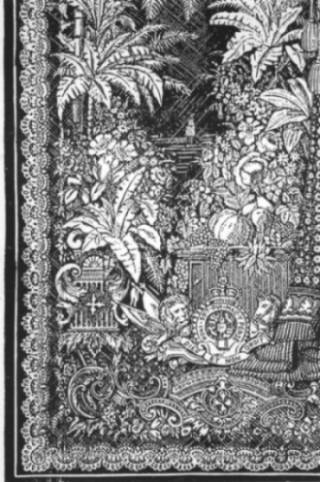
Table cloth with
scene by Rembrandt,
shown at world exhibition 1867

Detail from
curtain, made in Nottingham,
shown at world exhibition 1862
| ANNE WANNER'S Textiles in History / publications |
| World exhibitions and
design, 1851 - 1878, as shown in publications from
Leipzig published in: CIETA-Bulletin No 75, 1998, p. 153 - 160, by Anne Wanner-JeanRichard |
| page 3 of 6 back - next |
| Contemporary reports: |
| The Journal of Leipzig considered the designer to be the most important person in an embroidery business, and Paris to be the centre of embroidery design. It distinguished between the so called dessinateurs du premier rang and their imitators. A number of Swiss and other manufacturers paid for their local designers to go to Paris for some weeks each year, other producers bought the patterns already finished in Paris, while the designers of smaller concerns made alterations to such patterns, to suit their requirements. The Journal of Leipzig also noted that Swiss embroidery was very often sold as French embroidery and that more than half of the broderies de Paris were made by Swiss ladies from Appenzell. A reason for this can be found in the English 1851 catalogue where it says: "hand embroidery is carried on in the eastern parts of Switzerland, where manual labour is extremely cheap" (9). In 1851 the manufacturers of eastern Switzerland exhibited only hand embroidery and the illustrations and descriptions show that their products were of high quality. The Swiss were concerned that other designers might copy their motives, although, if we compare Swiss embroidery with other exhibits, it is clear that there was no particular Swiss style. | In 1862, the
Brockhaus catalogue (10) laid specially emphasis
on Nottingham as a major centre of
British cotton white works, commenting that half the
world would be supplied from Nottingham with lace, robes,
curtains, scarves and so on, and that this boom in the
British thread industry was due to the development of
machines. The publication compared Nottingham's success
to the situation in eastern Switzerland, where production
had declined because in that country the manufacurers
were late in importing improved machines. A brief
remark in connection with this: in Nottingham, first
attempts with machine lace go back to the 18th century.
Good results were obtained with the Pusher machine, which
was invented in 1812 and used till 1870. |
Table cloth with
scene by Rembrandt, |
Detail from
curtain, made in Nottingham, |
| London | Designers | Reports | Machines | Style | Later 19th c. |
| content | Last revised July 29, 2004 |